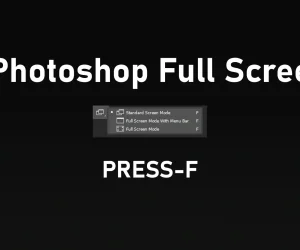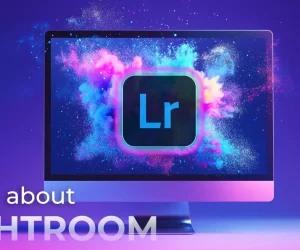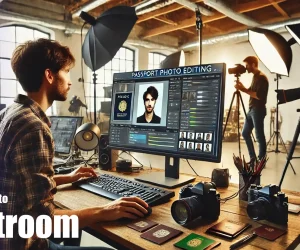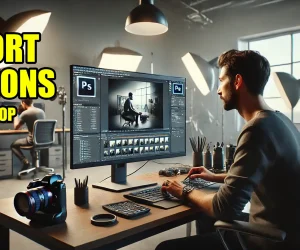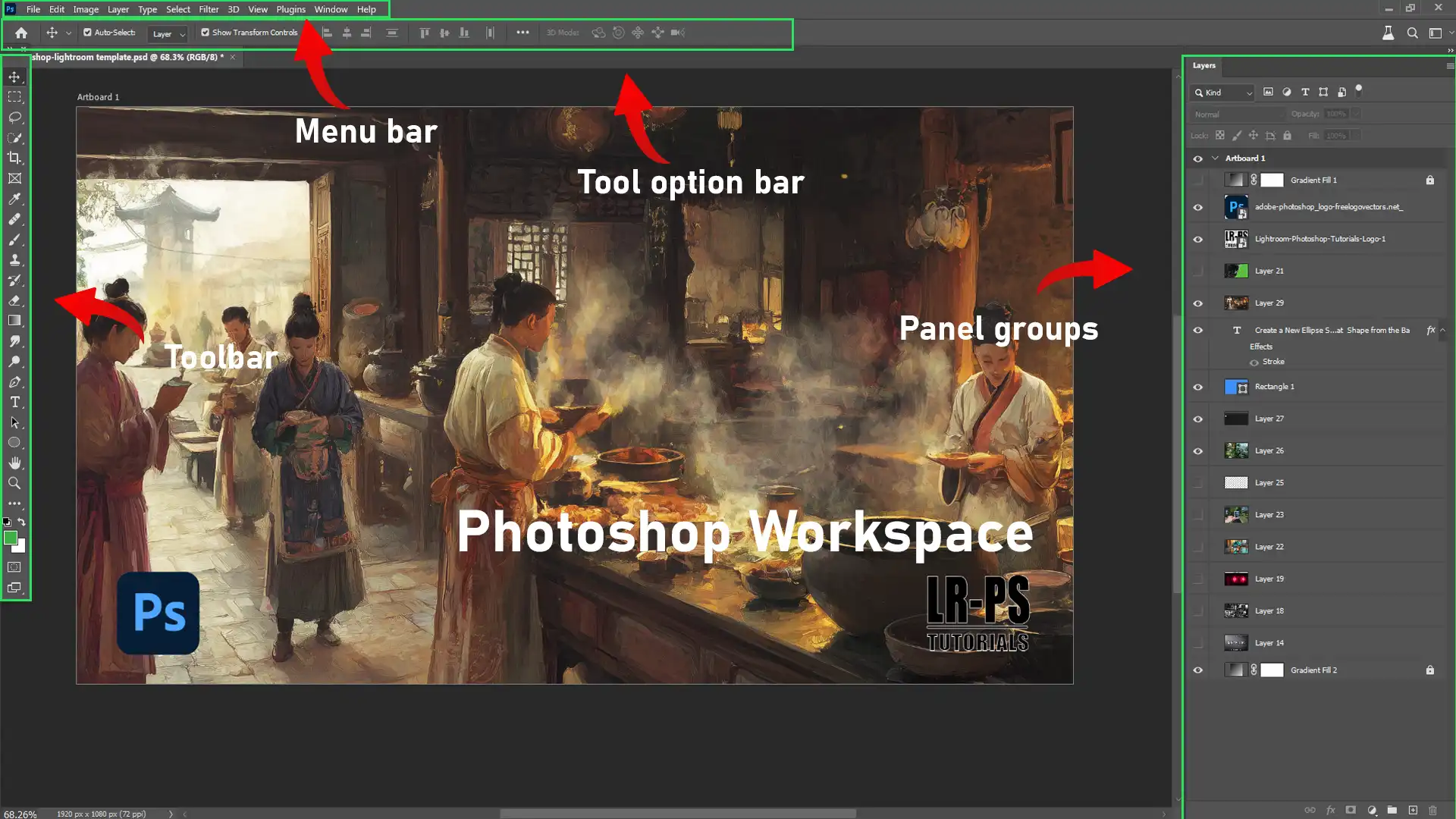
Stepping into the Photoshop workspace can feel like entering a whole new world. With so many tools and options at your fingertips, it’s easy to feel overwhelmed.
In this article, I’ll guide you through the essentials, making everything clear and manageable.
Discover how to set up your workspace for efficiency, explore the key features, and learn handy tips to streamline your workflow.
Whether you’re a beginner or looking to polish your skills, you’ll find valuable insights to boost your creativity and productivity.
Ready to dive in and transform your editing experience?
Let’s get started!
Table of Contents
Exploring the Default Photoshop Workspace
The default workspace in Adobe Photoshop is where the magic begins. It is meticulously designed to give you easy access to essential tools in Photoshop, and essential tools in Lightroom as well, and features.
Let us explore each component and understand how it contributes to a seamless workflow.
Components of the Default Workspace
The default workspace in Photoshop consists of several areas and panels, each serving a specific purpose.
Below are the key components:
Tools Panel
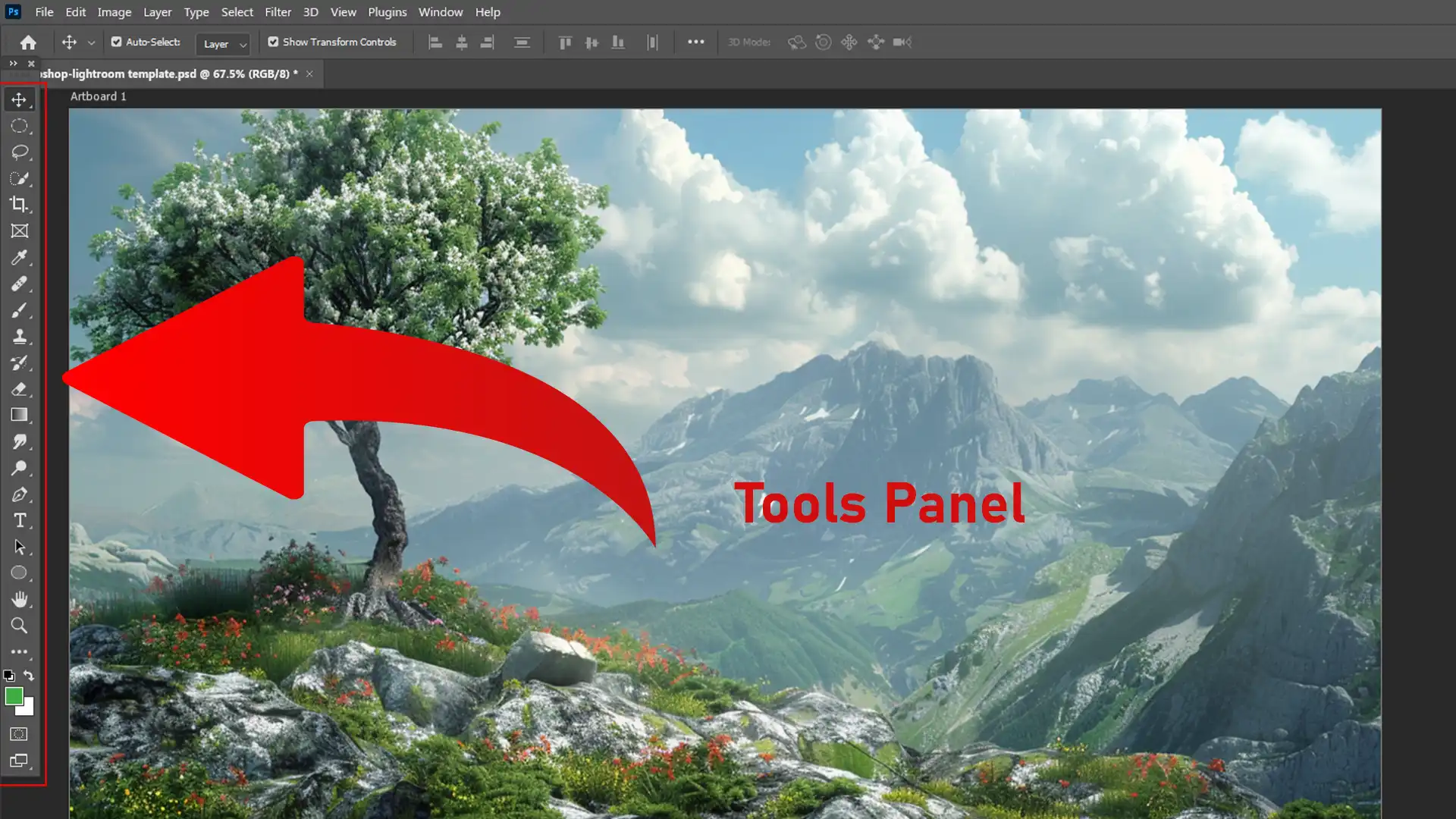
The tools panel is on the left side, it’s your primary resource for creating and editing. You find selection tools, brushes, and more.
Everything is at your fingertips.
In the tools panel, the content-aware tool stands out as a powerful feature for editing. This tool helps seamlessly remove or replace parts of your image, enhancing your workflow.
Options Bar
Above the documents window, the options bar provides context-sensitive settings, allowing users to tweak tool parameters swiftly.
For instance, if you select the brush tool, the bar changes to show brush size and opacity.
This bar adapts as per the tool you use.
Panels and Menus
Panels and menus like Layers panel, Color, and History are by default on the right. You can rearrange panels to fit your working style.
Accessing these panels is vital as they hold crucial controls like layer management and color options.
Mastering the Layers panel can be greatly enhanced with layers shortcuts such as the new layer shortcut.
These shortcuts make managing layers quicker and more efficient.
Pro Tip: For further enhancement make sure to check out Photoshop layering tutorials.
Panel Group
On the right, panels like Layers, Channels, and Paths are grouped together for easy access. Grouping keeps the interface tidy while ensuring usability.
Discovering how to use these panels effectively improves your workflow significantly. To manage groups, just drag them around or into empty slots.
Document Window
In the center, your creative space lies within the documents window. Floating document window docking is an option, you can keep it free or dock it.
The choice depends on what you’re comfortable with. View multiple documents in floating windows for comparison.
Swatches panel
The Swatches panel in Adobe Photoshop is an essential tool for managing colors efficiently within your painting workspace.
Located on the right side by default, the Swatches panel allows you to store and quickly access your frequently used colors.
By customizing the Swatches panel, you can create a palette of colors that perfectly suits your project’s needs.
You can easily add, remove, and organize colors within the Swatches panel to streamline your workflow and ensure consistency throughout your designs.
Whether you’re adjusting hues or selecting new shades, the Swatches panel is integral to maintaining an effective and organized painting workspace.
Making It Yours: Custom Workspaces
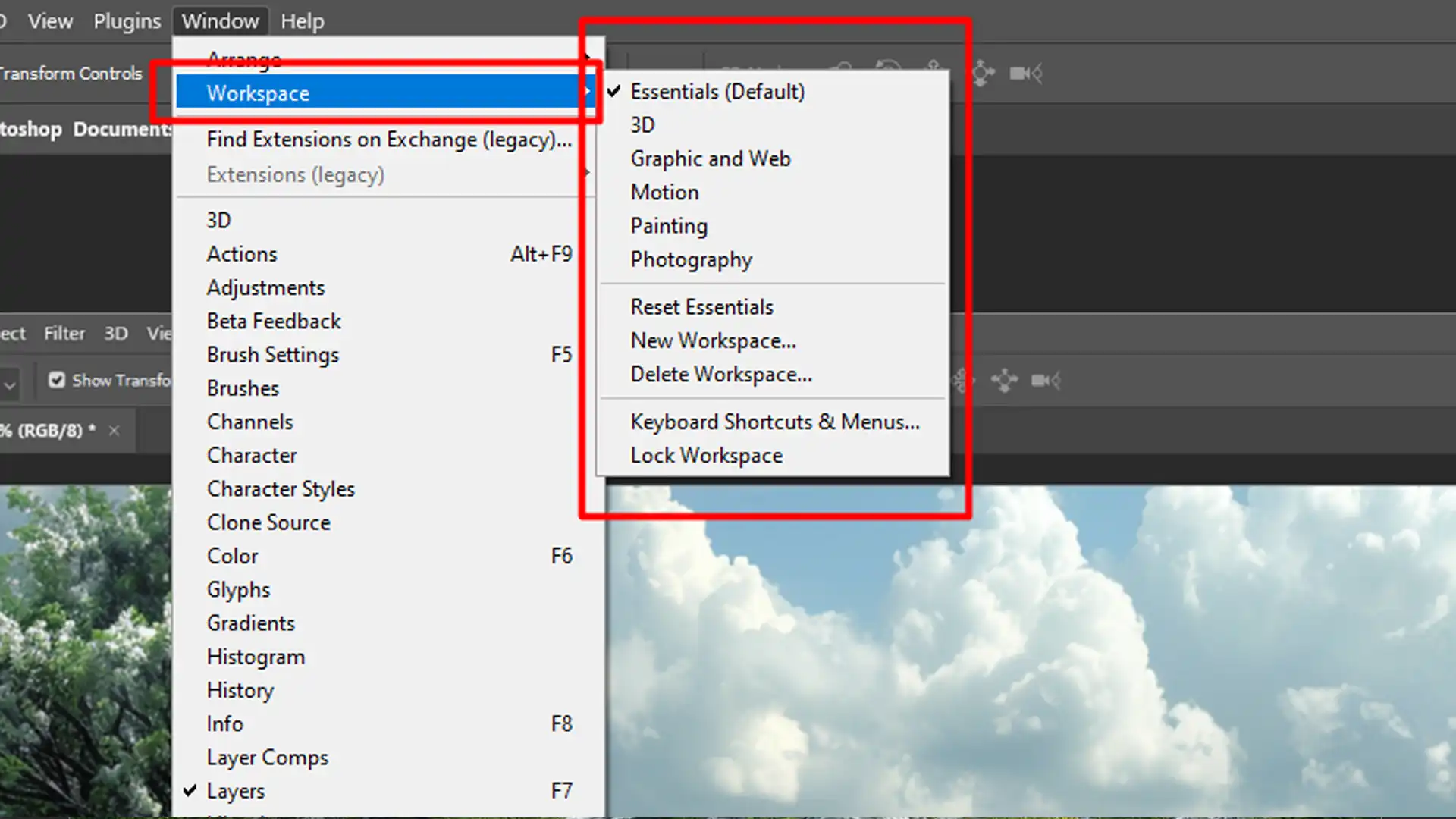
You can create a custom workspace that matches your needs. You can start from scratch or modify existing panels.
Use the ‘Window’ menus to add panels or the ‘Workspace’ dropdown to switch. Saving a new workspace ensures your changes won’t be lost.
Don’t hesitate to delete workspaces you no longer need. Custom workspaces offer flexibility tailored to your projects.
User Interface Preferences
We’ve learned the layout, now let’s dive into Photoshop’s interface preferences to enhance your experience.
Adjusting these preferences can make Photoshop feel more intuitive, like setting up custom keyboard shortcuts to speed up tasks, or choosing interface colors that are easy on your eyes.
Experimenting until you find settings that suit your workflow is key.
Embrace Preset Workspace
Many new users overlook them, but preset workspace can jump-start your projects. Switching between Photography and Graphics & Web can save time and is highly practical. If you’d rather experiment with custom setups, utilize the ‘Window’ menus efficiently.
Don’t forget to press tab to hide and reveal hidden panels easily, it’ll tidy up your workspace temporarily.
Customizing Your Photoshop Workspace
Ever find yourself digging around for a tool?
Customizing your Photoshop workspace can save you time. A custom workspace makes it easier to access the tools you use most, cutting down on hunt-and-peck struggles.
The essentials workspace is fine, but tweaking it for your needs can be a game-changer.
Steps to Create a Custom Photoshop Workspace
Start with the window menus. Open it up and arrange your panel layout. Drag panels where you want them.
Once you’re happy, go back to the window menus, hover over workspace, and click New Workspace.
Give it a name. Done!
Switching Between Workspaces
Switching workspaces is as simple as a few clicks:
- Head to the window menu and select workspace.
- Here, you’ll find several preset workspaces and any custom workspace you've created.
- Just click, and Photoshop does the rest.
- If you need to delete workspace you no longer use, you can handle that from the same menu.
Optimizing Panel Layout
Having the right panel layout is crucial. For instance, I keep the color and swatches panels together. It helps when I’m playing with different shades.
The brush presets panel? Always within arm’s reach. You get the idea, organize for what you do most often.
Pro Tip: Get into the habit of using keyboard shortcuts for frequently used tools. It’s a massive time saver. Plus, kinetic learning makes these shortcuts stick better.
Additionally, understanding the difference between Photoshop and Lightroom can help you decide which software best suits your editing needs.
How To Use Panels
Are you trying to make Photoshop easier to use?
Let’s dive into panels and see how they work.
Customizing Your Photoshop Workspace
You can start with the essentials workspace. This setup includes essential tools for basic tasks.
From here, you can tailor your space to fit your unique needs.
Optimizing Panel Layouts

- Open the window menus and arrange your panel layout.
- Save your layout by selecting "New Workspace" from the submenu.
- Group frequently used panels, like colors and brushes, together. This keeps them within reach.
Switching Workspaces
- Select desired workspaces, either preset or custom, from the window menus.
- You can delete unused workspaces to keep your options clear and simple.
Keyboard Shortcuts
Use keyboard shortcuts for frequently used tools. It saves time and makes working in Photoshop faster. For instance, mastering essential tools in Photoshop can significantly enhance your workflow efficiency.
Investment In Education
Consider investing in quality tutorials. They can provide additional tips and tricks that might not be obvious at first glance. T
his is a great way to master your Photoshop workspace.
Photoshop And Lightroom
Understand the key differences between Photoshop and Lightroom. You’ll know which software is best for your needs.
For example, while Photoshop is excellent for detailed edits, Lightroom excels in batch processing and organization.
Pro Tip: in frequently used menu items to the top of your panel menus. It makes navigation quicker.
Using the Window Menu
Let’s dive into how we can make better use of the Window Menus.
Accessing Panels via the Window Menu

When you want to open a specific panel, where do you go?
You don’t need to remember complex steps.
Instead, access them directly from the Window Menus in the top bar. It’s straightforward.
- Click on the "Window" option.
- Select the panel you need from the dropdown list.
Your panel opens right away. It’s consistent and always in the same place.
Customizing Panels with the Window Menu
Customizing panels is the trick to making your workflow faster. Imagine not having to hunt for that one tool all the time.
Here’s what you do:
- Open the Window Menus and click 'Workspace'.
- Choose 'New Workspace' to start setting up your tools.
- Drag and drop panels precisely where you want them.
Now, every time you use that workspace in Photoshop, your favorite tools are right where you left them.
Custom panel arrangements fit how you work, making tasks quicker and easier.
The Benefits of Optimizing Your Workflow
Enhanced workflow equals more productivity. It’s not just about keeping things tidy. It’s about having everything at your fingertips to save time.
Here’s the core benefit: maximize your photoshop workspace use so everything you need is accessible.
Pro Tip: Add your most-used panels to a new workspace. Name this “Most Used Tools” It’ll save clicks, streamline your process, and reduce headaches.
Switch between different window workspace layouts by navigating through the Window Menu.
This way, whether you’re editing photos or creating graphics, your tools are always available and easy to find.
In conclusion, customizing your Photoshop layout using the Window Menu isn’t just helpful, it’s essential in achieving an efficient and user-friendly photoshop user interface.
Accessing panels and arranging them as needed takes the guesswork out of your day, letting you focus on your creative projects more smoothly.
So, make these modifications today and notice a difference immediately.
Tips and Tricks for an Efficient Photoshop Workspace
To enhance your efficiency in Photoshop, it’s crucial to familiarize yourself with various elements, including the brush panel, image window, and histogram panel.
Start by customizing your workspace, ensuring that tools like the navigator panel and saved workspace are easily accessible.
Utilize the double arrow button to switch between different views and press Ctrl for quick shortcuts. If needed, reset essentials to default settings to quickly regain a clean slate.
By mastering these features and understanding how they interact, you can streamline your workflow and make the most out of every editing session.
| Feature | Photoshop Workspace | Other Editing Software |
|---|---|---|
| Customizable Panels | Yes | Varies by software |
| Keyboard Shortcuts | Extensive | Limited in some programs |
| Tool Integration | High | Varies by software |
| Workspace Layout | Flexible | Often fixed |
| Tool Presets | Customizable | Often standard |
Organizing Your Tools Panel
When using Photoshop, organizing your tools panel helps you work faster. Drag and drop your most-used tools to the top of the panel.
This saves time by reducing the need to scroll. Additionally, hide any tools you rarely use to keep your workspace clean. In the essentials workspace, this customization boosts efficiency.
Remember to reset your tools when needed by using the “Reset Tools” option in the tools menu.
When organizing your Tools Panel, don’t overlook the frame tool. It’s essential for creating placeholders and managing your designs.
Integrating this tool into your workflow can streamline the layout process, making it easier to adjust and refine your visuals.
Utilizing Keyboard Shortcuts
Keyboard shortcuts are a game-changer in Photoshop. They help you avoid digging through the menu items repeatedly.
For common actions, memorize one or two shortcuts at a time:
- Pressing the "V" key selects the Move tool instantly.
- Shortcuts like "Ctrl + S" for save or "Ctrl + Z" for undo are lifesavers.
In the essentials workspace, these shortcuts make tasks quicker and smoother.
Learning Photoshop shortcuts can significantly enhance your productivity.
Managing Multiple Photoshop Workspaces
Managing multiple workspaces in Photoshop is essential for handling different projects. Create a new window workspace in photoshop for specific tasks like photo editing or graphic design.
You can switch between these setups via the window workspace menu. This method tailors your workspace to fit the task at hand. If you make changes, save them under a new workspace name for easy access.
In the essentials workspace, this feature enhances your workflow adaptability.
Pro Tip: Customize your dialog box settings to streamline your process. Frequent adjustments to the dialog box save time and reduce frustration.
By optimizing your dialog box preferences, you can ensure that every aspect of your work is as smooth and effective as possible.
The Photoshop toolbar is your gateway to a wide range of editing tools and features.
By familiarizing yourself with the Photoshop toolbar, you can quickly access and utilize various functions to enhance your workflow.
Frequently Asked Questions

What is Photoshop Workspace?
The Photoshop workspace refers to the arrangement and visibility of panels, tools, and menus within the Photoshop program.\n It’s designed to help you manage and access the tools and features you need for your projects efficiently.
Where is the workspaces menu in Photoshop?
You can find the workspaces menu in Photoshop at the top right corner of the screen. Look for a dropdown menu labeled with the name of the current workspace or an icon resembling a series of small squares.\n This menu allows you to switch between different workspace setups.
How do I get my workspace back in Photoshop?
- Go to the Window menu.
- Hover over Workspace.
- Select Reset Workspace from the submenu.
- Choose the workspace you want to reset to its default layout.
How do I add more workspaces in Photoshop?
- Open the Window menu.
- Select Workspace and then New Workspace.
- Type a name for your new workspace.
- Customize by selecting which panels and tools you want to include.
- Click Save to add your customized workspace.
Conclusion
In conclusion, getting comfortable with the Photoshop workspace can make a big difference in how you edit your photos. I’ve found that setting up your workspace to match your style can save a lot of time and make the process more enjoyable.
Whether you’re just starting out or looking to improve, understanding the layout and tools can really help.
For more detailed guidance, you can check out my Photoshop course and Lightroom course. If you’re ready to dive deeper into Photoshop or Lightroom, you can also explore these options: Adobe Photoshop and Adobe Lightroom.
Happy editing!
Read more about Photoshop & Lightroom:


